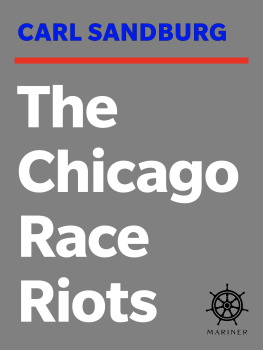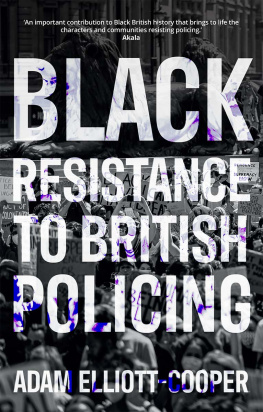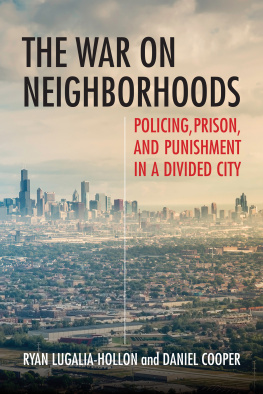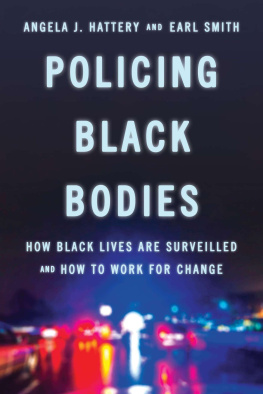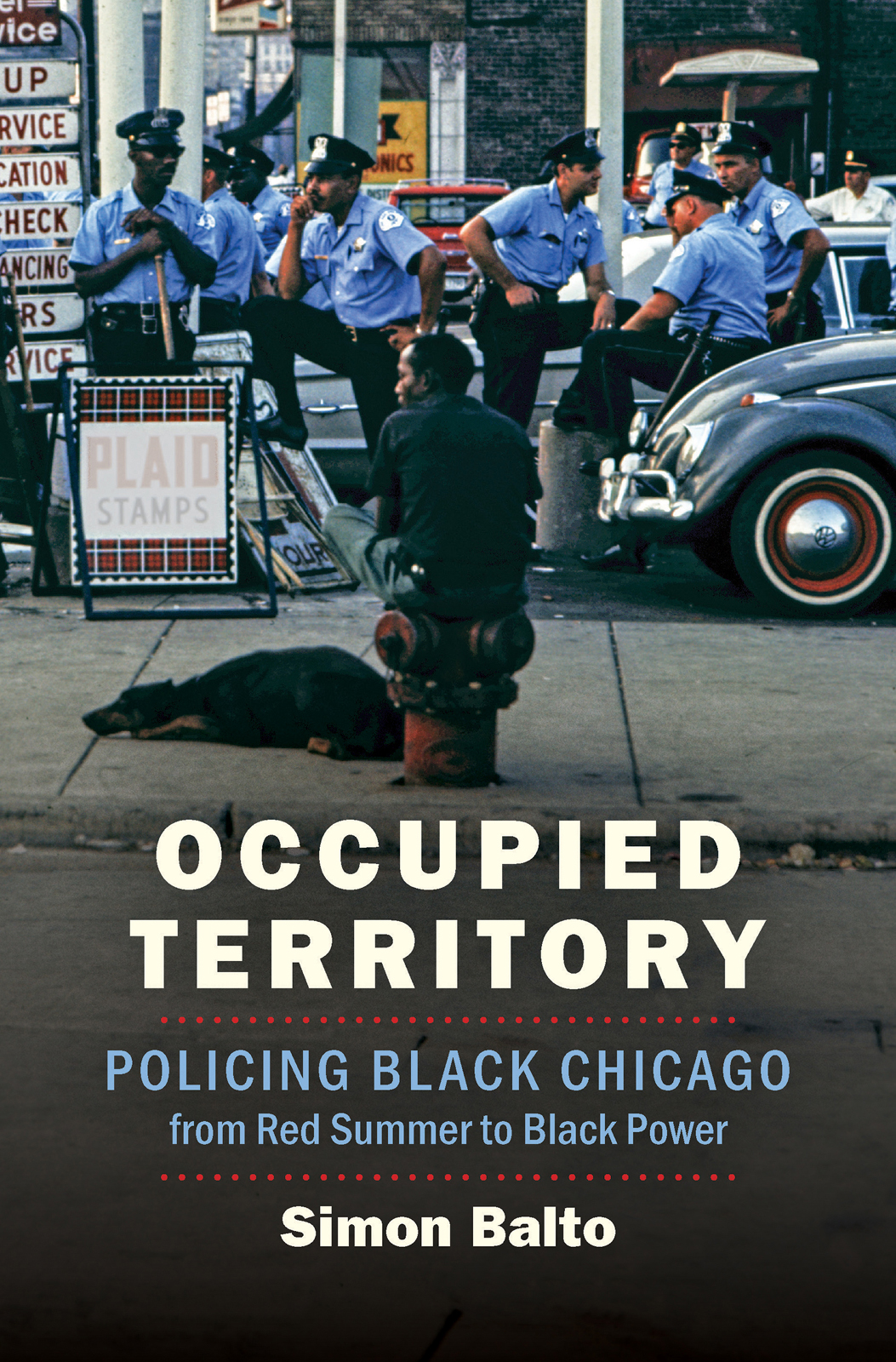Rhonda Y. Williams
Peniel E. Joseph
Vicki L. Ruiz
The Justice, Power, and Politics series publishes new works in history that explore the myriad struggles for justice, battles for power, and shifts in politics that have shaped the United States over time. Through the lenses of justice, power, and politics, the series seeks to broaden scholarly debates about Americas past as well as to inform public discussions about its future.
More information on the series, including a complete list of books published, is available at http://justicepowerandpolitics.com/.
OCCUPIED
TERRITORY
POLICING BLACK
CHICAGO FROM
RED SUMMER TO
BLACK POWER
SIMON BALTO
The University of North Carolina Press | Chapel Hill
This book was published with the assistance of the Authors Fund of the University of North Carolina Press.
2019 The University of North Carolina Press
All rights reserved
Manufactured in the United States of America
Designed by April Leidig
Set in Arnhem by Copperline Book Services
The University of North Carolina Press has been a member of the Green Press Initiative since 2003.
Cover photograph courtesy of the Chicago History Museum
Library of Congress Cataloging-in-Publication Data
Names: Balto, Simon, author.
Title: Occupied territory : policing black Chicago from Red Summer to black power / by Simon Balto.
Other titles: Justice, power, and politics.
Description: Chapel Hill : University of North Carolina Press, [2019] | Series: Justice, power, and politics | Includes bibliographical references and index.
Identifiers: LCCN 2018049256| ISBN 9781469649597 (cloth : alk. paper) | ISBN 9781469649603 (ebook)
Subjects: LCSH: Chicago (Ill.) Police DepartmentHistory20th century. | Discrimination in law enforcementIllinoisChicagoHistory20th century. | African AmericansCivil rightsIllinoisChicagoHistory 20th century. | Chicago (Ill.)Race relationsHistory20th century.
Classification: LCC HV8148.C4 B35 2019 | DDC 363.2/308900977311dc23 LC record available at https://lccn.loc.gov/2018049256
For those who dream and work to bring about a better world, and in memory of my mother, who spent her life doing both of those things
CONTENTS
Prologue: The Promised Land and the Devils Sanctum:
The Risings of the Chicago Police Department and Black Chicago
1 Negro Distrust of the Police Increased:
Migration, Prohibition, and Regime-Building in the 1920s
2 You Cant Shoot All of Us:
Radical Politics, Machine Politics, and Law and Order in the Great Depression
3 Whose Police?:
Race, Privilege, and Policing in Postwar Chicago
4 The Law Has a Bad Opinion of Me:
Chicagos Punitive Turn
5 Occupied Territory:
Reform and Racialization
6 Shoot to Kill:
Rebellion and Retrenchment in PostCivil Rights Chicago
7 Do You Consider Revolution to Be a Crime?:
Fighting for Police Reform
ABBREVIATIONS
| AAPL | Afro-American Patrolmens League |
| ACLU | American Civil Liberties Union |
| BCC | Black Crime Commission |
| BPP | Black Panther Party |
| CCC | Chicago Crime Commission |
| CCCCP | Chicago Campaign for Community Control of Police |
| CCHR | Chicago Commission on Human Relations |
| CCRR | Chicago Commission on Race Relations |
| CCWWC | Coalition of Concerned Women in the War on Crime |
| CFM | Chicago Freedom Movement |
| CHA | Chicago Housing Authority |
| CIO | Congress of Industrial Organizations |
| COP | Chicago Confederation of Police |
| CORE | Congress of Racial Equality |
| CP | Communist Party |
| CPA | Chicago Patrolmens Association |
| CPD | Chicago Police Department |
| CRC | Civil Rights Congress |
| CUCA | Coalition for United Community Action |
| CUL | Chicago Urban League |
| DNC | Democratic National Convention |
| FBI | Federal Bureau of Investigation |
| FBN | Federal Bureau of Narcotics |
| FHA | Federal Housing Administration |
| FOP | Fraternal Order of Police |
| GIU | Gang Intelligence Unit |
| GLCC | Greater Lawndale Conservation Commission |
| HOLC | Home Owners Loan Corporation |
| IAD | Internal Affairs Division |
| IID | Internal Investigations Division |
| LEAA | Law Enforcement Assistance Administration |
| MCHR | Mayors Commission on Human Relations |
| NAACP | National Association for the Advancement of Colored People |
| NLRL | Negro Labor Relations League |
| NNC | National Negro Congress |
| OKPA | Oakland-Kenwood Property Association |
| PWOC | Packinghouse Workers Organizing Committee |
| SCLC | Southern Christian Leadership Conference |
| SNCC | Student Non-Violent Coordinating Committee |
| SWOC | Steel Workers Organizing Committee |
| UC | Unemployed Council |
| YSA | Young Socialist Alliance |
OCCUPIED TERRITORY

MAP 1. Chicago community areas, indicating areas of major black residency, 1920. Map based on original map by the Chicago Area Geographic Information Study at the University of Illinois at Chicago.
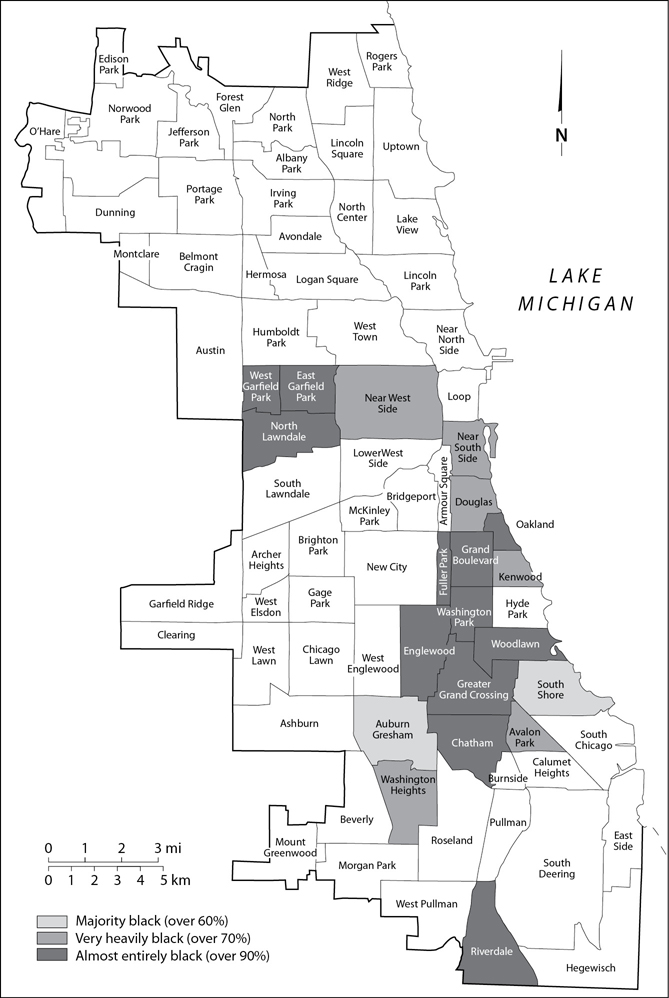
MAP 2. Chicago community areas, indicating areas of major black residency, 1970. Map based on original map by the Chicago Area Geographic Information Study at the University of Illinois at Chicago.
Introduction
OVERPOLICED AND UNDERPROTECTED IN AMERICA
Chicagos black neighborhoods are the most overpatrolled and underprotected in the city, testified Howard Saffold, a black police officer with the Chicago Police Department (CPD). An assemblage of community members, experts, and activists looked on from their seats inside the Everett Dirksen Federal Building in downtown Chicago. To them, the departments primary failings were twofold: first, black people were constantly subjected to abuse, harassment, and hypersurveillance (overpatrolled). Second, they were continuously at risk within their neighborhoods anyway (underprotected).
The black neighborhoods that Saffold talked about were suffering badly from neglect and violence. As the by-product of numerous socioeconomic and political processes, and as the more intentional result of others, Chicago was roughly as segregated a place as one might find in America. The Dirksen Building where Saffold testified sat only five miles north of the heart of the black South Side, and even closer to the largest concentration of black communities on the West Side. From the chain-link-enclosed balconies of the Robert Taylor Homes and the Cabrini Green projects, people could see the towering majesty of the downtown Loops skyscrapers material prosperity, embodied in steel, glass, and concrete. But the Loops residents rarely looked back in a meaningful way. If they had, they would have seen their fellow citizens living in terror. The blood of more than seven hundred murder victims soaked the citys streets that year the vast majority on the West and South Sides. Before the decade closed, more than eight thousand Chicagoans, most of them black, would be registered on police homicide ledgers.


